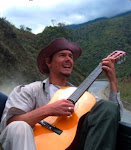After a month in the rain and mud, nothing sounded better than heading to the coast to dry out for a minute!
Much of the coast of south America is under the influence of the Humbolt current.
This cold current flows from the Antarctic ocean up the west coast of south america to the equator, where it meets the warm Panama current from the north and heads out into the Pacific.
It is the most productive marine ecosystem in the world,
accounting for approximately 18-20% of the world’s fish catch,
and contributing to the diversity of the Galapagos islands.
For us here on land though, there are a couple of important influences of this current,
Both center around the relationship between water temperature and the ability of the air above to hold onto moisture.
Warm air holds more moisture than cold air.
One of the reasons that it is so wet at los cedros is that all of the moist air associated with the Panama current collides with the cold air associated with the Humbolt current and the moisture falls to the ground.
The Choco phytogeographic region,
(that part of NW south America where these currents collide, and home to los cedros!)
is arguable one of the wettest places on earth.
The other big influence of the Humbolt current is that much of the coast of south America, chile, peru and the southern half of Ecuador is very dry, receiving as little as 10 inches of rain/year in certain regions.
A welcome respite from the 100% humidity we were leaving behind!
Hitch-hiking out of quito, we found ourselves cresting the western range of the Andes and falling through clouds, the highway draped in ferns and waterfalls……
I am not sure if it actually ever rained, or if we got as wet as we did, simply by rushing through the condensing air in the back of a truck!

Soon we left the lush slopes behind and entered the broad coastal plains,
As night fell, we got on a bus, and missed most of the acres of bananas, oil palm and sugarcane that we rumbled through…….
Slept in Manta, a bustling port city that until recently was home to a US military base that was used largely in the “war on drugs.” (interpret the quotation marks anyway you like!)
Couldn’t wait to leave in the morning, despite the coconut water, vended from 3-wheeled bicycles…..
Wanted to leave so quick in fact, that we almost let our selves be talked into riding the bus down to Puerto Lopez!!!
But patience prevailed, and soon enough we were hiking out of town, thumbs in the air!
Intriguing landscape, reminded me of traveling in Baja some years ago……
The dry, dry landscape, contrasting against the sea
Dry tropical forest once occupied more land area than tropical rainforest.
Some 42% of all intra-tropical vegetation.
However, it is easily converted to pasture and is slow to recover…….
In Ecuador less than 2% of this forest type remains,
a statistic which is unfortunately true for most tropical dry forest regions in the world.
Unless it is worse!
(Central America has less than one-tenth of one percent of its original dry forests).
it took us the better part of a day to hitch the 120km down the coast
6 rides in all……
hanging off the bumper of pick-ups full of people,
eating bologne sandwiches and listening to manu chao in a sedan driven by tourists form quito,
and hunkering down in a truck full of wires and electrical supplies to avoid the fish guts and bloody water, flying out of the trucks in front of us!!!
We arrived in Puerto Lopez, tired and sunburned!
‘Accidentally’ rented a house on the beach…..
(we had been looking for a hostal,
but this was cheaper and nicer than anything else we had seen!)
and quickly discovered some aloe growing nearby.
Nothing like aloe directly applied to burnt flesh to remind us of the power of plants!
Fried fish for diner,
A moonlit walk through the warm waves
And we called it a day…..

Puerto lopez is just south of the main entrance to Parque Nacional Machalilla
A protected area includes 50km of coastline
(including isla de la plata – an important breeding ground for seabirds such as boobies with various colored feet, frigate birds and albatross - euphemistically known as ‘the poor-man’s galapagos’),
and extending inland to the humid forests of the coastal mountains.

Red-footed Booby
This is one of very few protected dry forests on the coast of south America
(lacking the conspicuous diversity and charismatic mega-fauna of its wetter counterparts……
While at first glance, a seeming desert,
we were lucky enough to arrive 3 weeks behind a rainstorm
and found sufficient botanical treasures to keep us enthralled for the better part of a week,
and then not wanting to leave!
After los cedros the relatively depauperate biota,
Was welcomingly easy to wrap our sun-drenched heads around…..
A few species of lovely lizards
Doves, vermillion fly-catchers, and golden tanangers flitting through the cacti and brush
Blooming prickly pears (opuntia sp)
Palo santo (Bursera graveolens)
its intense aroma accentuated by the beating tropical sun
shrubby boraginaceaes (Cordia lutea)
pelicans
crabs
plovers
beaches white with the remains of once living coral
others with black sand that hurt our barefeet with its radiating heat

jesse and I, hanging out at the great look out point
found ourselves defacto naturalists
answering questions about plants and birds, for various folks
from Russia to argentina!
Made me think that a field guide to the dry forest, night be a simpler undertaking that one to the cloud forest!!!
anyway, enough for now
abrazos
t
 |
| Ecuador Coast |
click on photo to view whole album





No hay comentarios:
Publicar un comentario